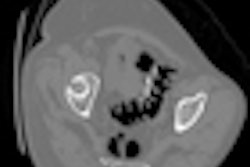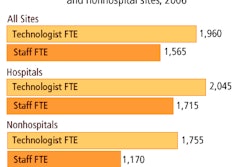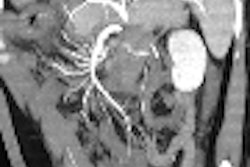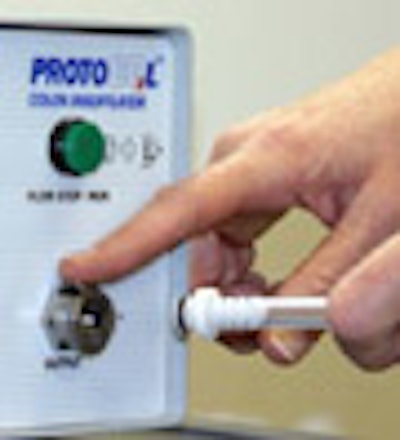
A group from the University of Chicago in Illinois has come up with a reliable way to reduce the discomfort of colonic insufflation needed to perform virtual colonoscopy. The results of a preliminary study show that the deflation maneuver is so reliable that the radiologists have made it standard practice in their department.
"Optimal colonic distension is intrinsically desirable for (virtual colonoscopy); however it's also associated with mild to severe pain," explained Dr. Abraham Dachman, a professor of radiology at the University of Chicago, at the 2006 International Symposium on Virtual Colonoscopy in Boston. "I've found that to be the case both with and without glucagon; although spasmolytics do increase patient comfort, they do not completely eliminate pain. They also increase small-bowel reflux and increase exam costs."
Following insufflation, virtual colonoscopy also requires that patients be scanned in both prone and supine positions. The worst pain in VC tends to come at the point in which the patient turns from the supine to prone position for the second half of the exam, Dachman said.
"As you get up on hands and knees and you flip over, you're basically tensing the abdominal muscles, and if you've watched the pressure on the pressure monitor -- it goes up tremendously and the highest pressures (up to 50 mm Hg) are generally at that point," Dachman said.
By reducing the pressure of CO2 gas used for insufflation before the patient turns over, the pain can be reduced significantly, he said. This can be accomplished easily by deflating the colon for just a few seconds before the patient turns over.
"I got thinking about this project from a self-paid (virtual colonoscopy) patient who was highly motivated to complete the exam -- and after the supine scan jumped off the table and said, 'I can't do this anymore.'" Dachman said. "That's how I discovered this maneuver. Our hypothesis is that brief colonic deflation between the supine and prone scans will diminish patient pain," he said.
Dachman introduced the maneuver and shared the study results at the symposium in October, and also credited the work of his co-investigators, University of Chicago medical students Kristy Urquiza, Shailen Bhatia, and David Saldanha.
Following automated CO2 insufflation to patient tolerance (ProtoCO2l, E-Z-EM, Lake Success, NY) the deflation maneuver involves opening the rectal tube to room pressure for about four seconds after completion of the supine scan.
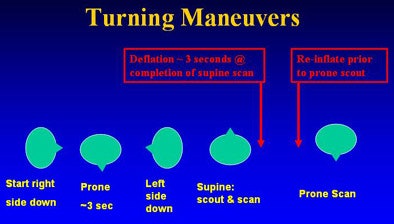 |
| During the VC exam, brief deflation of about four seconds' duration is performed immediately after supine scanning and before prone scanning. All images courtesy of Dr. Abraham Dachman. |
"We usually set the insufflator to ... around 23, 24 mm Hg," Dachman explained. The turning maneuver begins after about 0.8 L of gas has been administered. "We have the patient do a 360° turn as we fill in the supine. We monitor the pressure and then someone else in the room monitors the patient's pain."
Supine scout and supine images are acquired first. Then the insufflator is turned off, the CO2 is turned off, and the tube is disconnected from the insufflator for about four seconds.
"It deflates the rectum but not the colon," Dachman said. After this brief deflation, the patient turns from supine to prone position, the colon is reinflated to normal exam pressure (23-25 mm Hg), and the prone scan is performed normally.
The technologists place a pillow under the patient's pelvis (not the abdomen) to make prone scanning easier, Dachman said. When these scans are complete, the rectal tube is left in place for about a minute until the patient is comfortable again.
The researchers logged colonic pressure (mm Hg) over the course of the exam, along with corresponding pain levels at each step in each of 38 patients undergoing VC (eight with glucagon, 30 without). Pressures were measured when patients were supine-inflated, supine-deflated, prone-deflated, and prone-reinflated, along with corresponding subjective pain scores (none, mild, moderate and severe on a scale of 0-4).
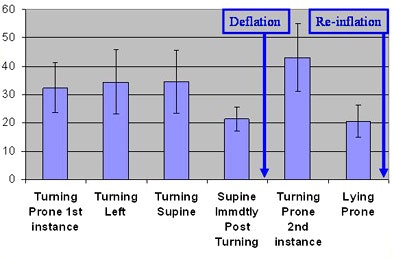 |
| Above, pressure monitoring throughout the VC exam indicates significant reduction in gas pressure following brief colonic deflation in all patients. Below, pressure dropped by a mean of 13.2 mm Hg following deflation. |
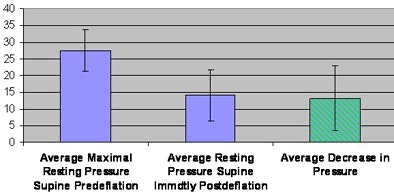 |
The results showed that perceived pain was reduced by the deflation maneuver in 100% of the patients. The supine preinsufflation average pain was 2.3, and the average deflated pain score was 1.0. The average decrease in pain was 1.3 on the scale, Dachman reported.
The average duration of reduced pain was six minutes -- enough time to turn the patient, process the supine images, and initialize the scanner for the prone scout, he said.
The four-second deflation reduced colonic pressure by 13.2 mm Hg (range 10-28) during the deflated period. It took five to 20 seconds for pressures to return to supine levels after inflation was restarted after turning the patient. Overall colonic distension -- evaluated for this study only subjectively -- was adequate in all views.
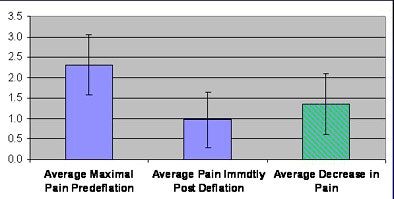 |
| All patients experienced a reduction in perceived pain following the four-second deflation, with a mean decrease on the perceived pain score (none, mild, moderate, and severe on a scale of 0-4) of 1.3. |
The deflation maneuver cuts pain by reducing gas pressure at its highest point during the exam, Dachman said. All patients experienced some relief of pain due to the deflation maneuver. Exam time was lengthened by only the 15-30 seconds needed to briefly deflate and reinflate for the prone scan. And relatively low pressures were generated during VC by use of deflation, he said, potentially enhancing the safety of the exam.
In theory, the risk of perforation in an otherwise normal case may be reduced in the setting of lower colonic pressures generated when this technique is used, Dachman said, emphasizing that this aspect had not been evaluated. As for limitations, there was no formal control group, though Dachman did evaluate a smaller group of controls before initiating the study.
"I wanted to make it a little more scientific and have a bigger control group, but I felt it wasn't ethical anymore," he said. "All these patients were so much more comfortable -- if I could get away with it, I'd rather not complete the control group."
"We think that patients will find (VC) more tolerable and desirable if this is employed routinely," Dachman said
By Eric Barnes
AuntMinnie.com staff writer
November 21, 2006
Related Reading
New data reveal higher efficacy for primary VC screening, October 18, 2006
Automated CO2 insufflation edges patient-controlled air in VC, June 2, 2006
Virtual colonoscopy shows favorable safety profile, May 5, 2006
Reading method, insufflation affect polyp measurements, November 4, 2006
Copyright © 2006 AuntMinnie.com




